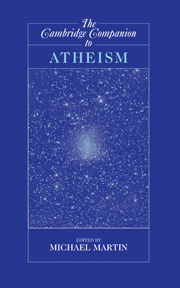General Introduction
Published online by Cambridge University Press: 28 January 2007
Summary
The purpose of this volume is to provide general readers and advanced students with an introduction to atheism: its history, present social context, legal implications, supporting arguments, implications for morality, and relation to other perspectives. This general introduction will set the stage for the chapters that follow.
ATHEISM, AGNOSTICISM, AND THEISM
The concept of atheism was developed historically in the context of Western monotheistic religions, and it still has its clearest application in this area. Applied, for example, to premodern non-Western contexts, the concept may be misleading. Moreover, even in the modern Western context “atheism ” has meant different things depending on changing conceptions of God. Nevertheless, it will be assumed in this volume that, if applied cautiously outside its clearest historical context, the concept of atheism can be illuminating for contemporary Western readers.
If you look up “atheism ” in a dictionary, you will find it defined as the belief that there is no God. Certainly, many people understand “atheism ” in this way. Yet this is not what the term means if one considers it from the point of view of its Greek roots. In Greek “a ” means “without ” or “not, ” and “theos ” means “god. ”1 From this standpoint, an atheist is someone without a belief in God; he or she need not be someone who believes that God does not exist.2 Still, there is a popular dictionary meaning of “atheism ” according to which an atheist is not simply one who holds no belief in the existence of a God or gods but is one who believes that there is no God or gods. This dictionary use of the term should not be overlooked. To avoid confusion, let us call it positive atheism and let us call the type of atheism derived from the original Greek roots negative atheism.
- Type
- Chapter
- Information
- The Cambridge Companion to Atheism , pp. 1 - 8Publisher: Cambridge University PressPrint publication year: 2006
- 3
- Cited by

